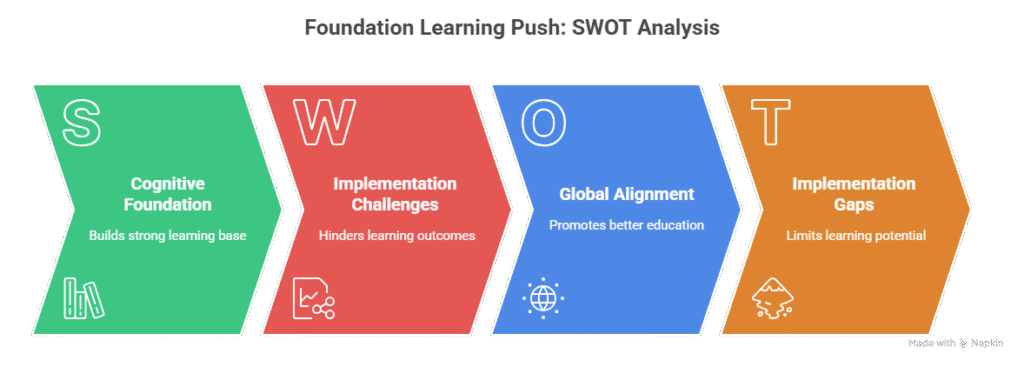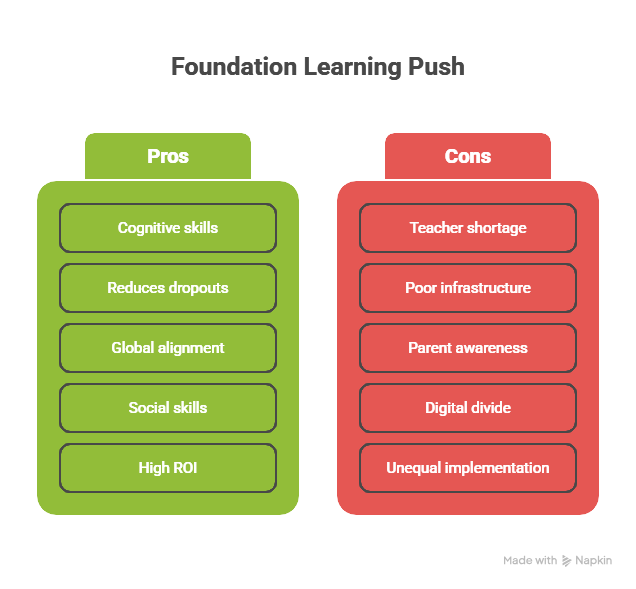Foundation Learning Push (NIPUN Bharat / FLN) for Kids 0–5 Years
Introduction
The first five years of a child’s life are the most crucial for brain development, cognitive growth, and lifelong learning ability. In India, the government has launched the NIPUN Bharat Mission under the National Education Policy (NEP) 2020 to ensure that every child achieves Foundational Literacy and Numeracy (FLN) by Grade 3.
For children aged 0–5 years, this mission focuses on early childhood care and education (ECCE), play-based learning, and parental involvement. A strong Foundation learning under NEP 2020 will not only reduces dropouts but also improves long-term educational and professional outcomes.
Here let’s know about Foundation Learning Push (NIPUN Bharat / FLN) for Kids 0–5 Years
👉 Explore more child-focused financial and education insights on our blog.

What is NIPUN Bharat Mission?
Launched by the Ministry of Education in 2021, NIPUN Bharat stands for National Initiative for Proficiency in Reading with Understanding and Numeracy.
- Goal: By 2026–27, every child in Grade 3 should achieve foundational learning.
- Target Age Group: 3–9 years, with a strong focus on 0–5 years preschool readiness.
- Approach: Play-based, activity-driven, multilingual, and inclusive.
This aligns with UNICEF’s Early Childhood Development (ECD) guidelines and India’s commitment to Sustainable Development Goal 4 (Quality Education).
Why Foundation Learning Matters for 0–5 Years
- 90% of brain development happens before age 5 (UNICEF).
- Early literacy and numeracy create a lifelong learning advantage.
- ECCE reduces learning poverty and increases school readiness.
- Investment in ECCE yields up to 13% annual return (World Bank).
Pros and Cons of Foundation Learning Push, i.e. ECCE and NIPUN Bharat advantages and drawbacks
| Pros (Advantages) | Cons (Challenges) |
|---|---|
| ✅ Builds strong cognitive, language, and numeracy base | ❌ Lack of trained ECCE teachers in many states |
| ✅ Reduces dropouts and learning poverty | ❌ Poor infrastructure in rural preschools & anganwadis |
| ✅ Aligns with global best practices (UNICEF, World Bank) | ❌ Limited awareness among parents about FLN |
| ✅ Improves social, emotional, and creative skills | ❌ Digital divide limits access to e-learning tools |
| ✅ High ROI in human capital (up to 13% yearly) | ❌ Unequal implementation across states |

Government Push for FLN
- NEP 2020: Prioritises ECCE with a 5+3+3+4 schooling system.
- Balvatika Model: Pre-primary classes in schools.
- NCERT Guidelines: Focus on play-based pedagogy.
- Teacher Training: Samagra Shiksha Abhiyan modules.
- Digital Resources: DIKSHA app for teachers and parents.
📌 For future financial planning of your child’s education, check our services.
Key Challenges in India
- Infrastructure Gaps: Anganwadi centres lack adequate facilities.
- Teacher Training Deficit: Many ECCE educators are untrained.
- Urban-Rural Divide: Rural kids face limited access.
- Parental Awareness: Many parents don’t know about FLN benefits.
- Digital Divide: Unequal access to devices and internet.
10-Point Checklist for Foundation Learning (0–5 Years) i.e. Early childhood education FLN checklist
- 🧩 Play-based activities (games, puzzles, stories).
- 📖 Early literacy (picture books, rhymes, storytelling).
- 🔢 Numeracy readiness (counting toys, shapes, comparisons).
- 🗣️ Language development (home language + exposure to others).
- 👨👩👧 Parental involvement in daily routines.
- 🏫 Safe preschool/anganwadi infrastructure.
- 🎓 Well-trained ECCE teachers.
- 🌍 Community and NGO participation.
- 💻 Digital/audio-visual tools for kids.
- 📊 Continuous assessment (not exam-based).
👉 Use our calculators to plan smart financial strategies for your child’s education.
Role of Parents & Community
- Parents are the first teachers—daily engagement boosts learning.
- Community-led awareness campaigns support ECCE.
- NGOs and private initiatives can fill resource gaps.
Learn more about us and how we help families build better futures.
Global Best Practices
- UNICEF: Play-based ECCE improves learning outcomes.
- World Bank: Low-cost scalable ECCE models transform communities.
- OECD Nations: ECCE reduces inequality and supports inclusive growth.
Conclusion
The foundation years (0–5) are critical for a child’s future. Through NIPUN Bharat and FLN initiatives, India is moving toward ensuring that every child enters Grade 1 school-ready. Parents, teachers, and communities must collaborate to close learning gaps and build a strong base for lifelong success.
👉 Need personalized advice? Reach out via our contact page.












